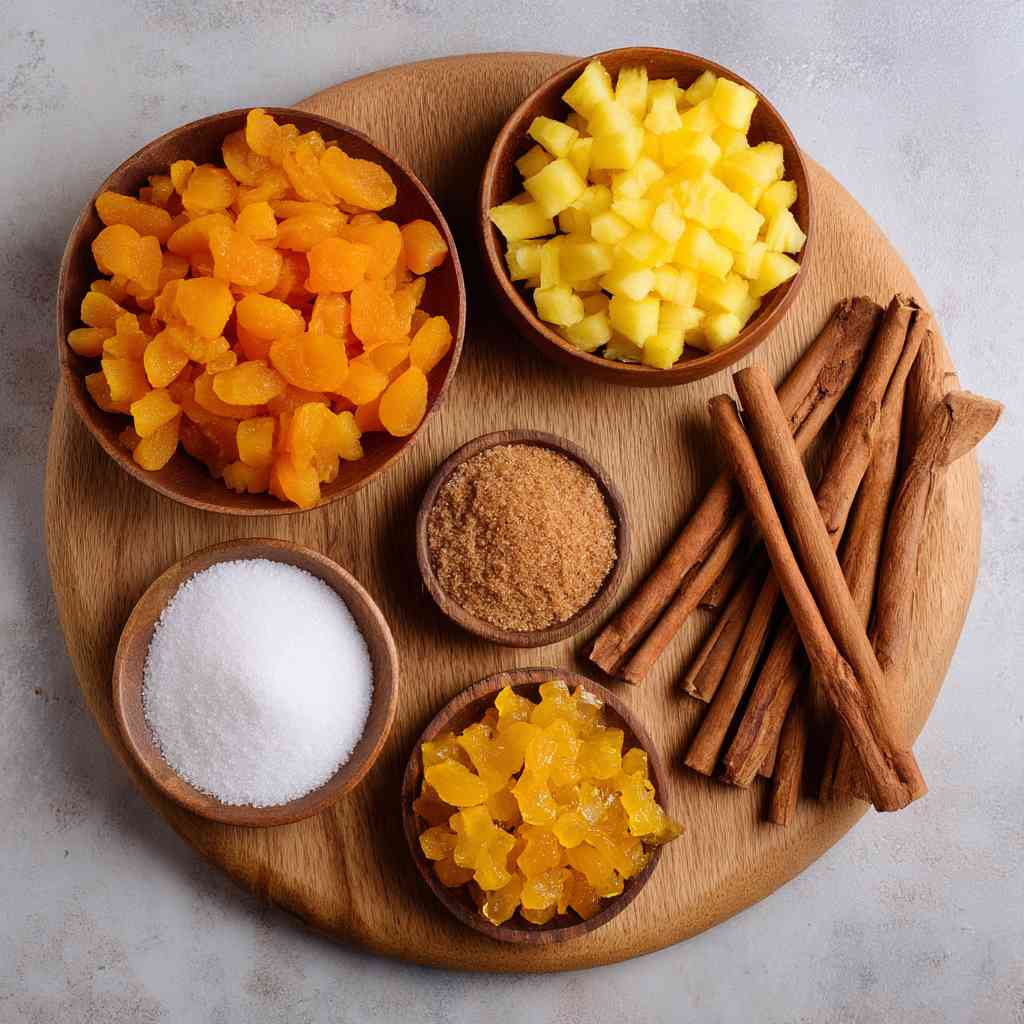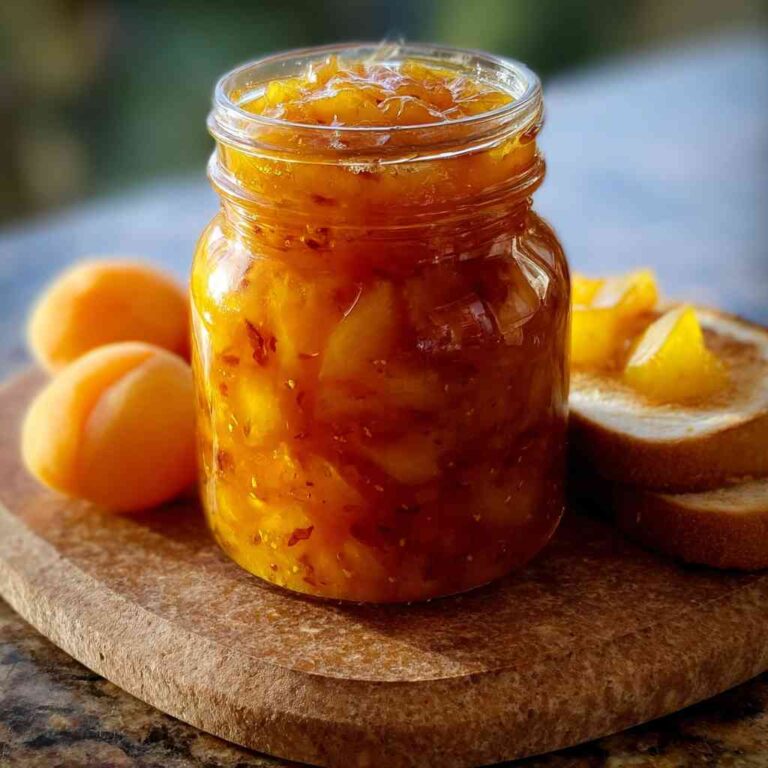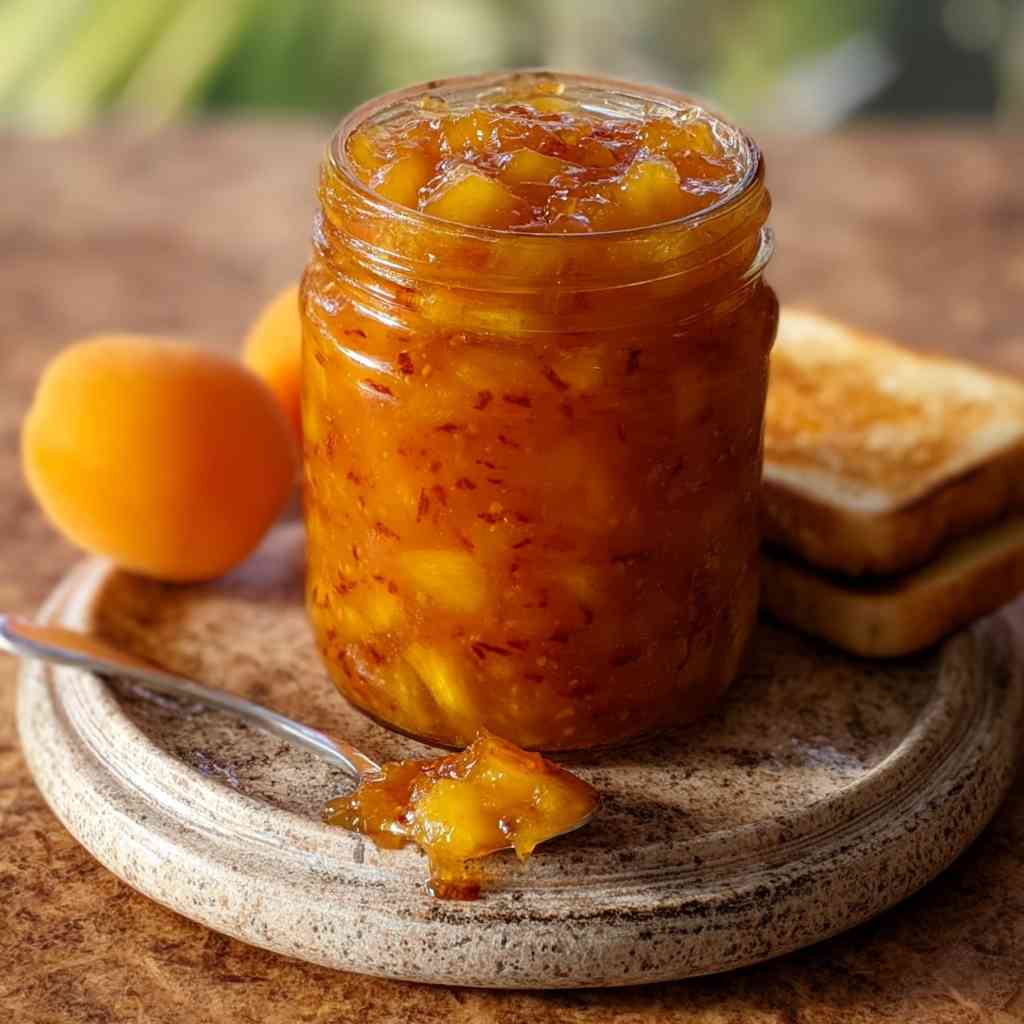Homemade jam doesn’t need to be complicated. This apricot pineapple jam recipe brings together the tangy sweetness of pineapple and the smooth richness of apricot for a spread that’s perfect on toast, biscuits, or even spooned over yogurt. With simple ingredients and no pectin required, this recipe is ideal for beginners and seasoned cooks alike. You’ll learn how to make jam with just fruit, sugar, and a little patience—plus how to know when it’s ready and how to store it for months of enjoyment.
Let’s begin with a look at what makes this tropical-meets-stone-fruit jam so special.
Table of Contents
Introduction to Apricot Pineapple Jam Recipe
What is apricot pineapple jam?
Apricot pineapple jam is a homemade fruit spread made by cooking fresh or canned apricots and pineapples with sugar and lemon juice. The combination delivers a golden jam with bright flavor and a satisfying texture that sits between chunky and smooth. Unlike commercial jams, this version contains no artificial preservatives or thickeners like pectin. Instead, it relies on natural fruit pectin and slow cooking to achieve the right consistency.
This apricot pineapple jam recipe is perfect if you love homemade spreads with a tropical twist. Use it on toast, biscuits, pancakes, and desserts, or serve it as a glaze for meats. Its tropical tang and balanced sweetness make it a standout addition to your pantry.
Looking for more pineapple-inspired recipes? Check out this delicious Hawaiian Pineapple Cake or try something fruity and fluffy like our Chinese Bakery Fruit Sponge Cake Recipe.
Why this fruity combo works perfectly
Pineapples bring brightness and acidity, while apricots add depth and a slight tartness. This pairing creates a jam that’s not only vibrant in taste but also rich in texture. The natural fruit sugars caramelize slightly during cooking, creating a jam with layers of flavor that’s neither too sharp nor too sweet.
This balance also helps the jam set naturally without needing pectin. Pineapples contain bromelain, which breaks down proteins, and apricots contribute enough pectin to help the mixture gel when cooked slowly over low heat. The final result? A spread that’s thick, shiny, and packed with fruit in every spoonful.
Ingredients for Apricot Pineapple Jam Recipe
Fresh or canned fruit: what to use
For a successful apricot pineapple jam recipe, start with the right fruit. Both fresh and canned options work, but each has its pros and cons. Fresh apricots are best in summer when they’re ripe and fragrant. If using fresh apricots, remove the pits and chop them into small chunks. Ripe ones are softer and break down easily during cooking.
Fresh pineapple gives the brightest flavor, but canned pineapple (in juice, not syrup) is a good substitute when fresh is unavailable. If using canned fruit, make sure to drain it thoroughly. Avoid using pineapple in heavy syrup—it adds unnecessary sugar and dulls the jam’s flavor.
A basic fruit ratio for this jam is equal parts apricot and pineapple by volume. Aim for about 2 cups of each. Keep in mind that the jam will cook down significantly, so start with more fruit than you think you need.
If you love smooth fruit-based desserts, try our Chinese Creamy Walnut Dessert Soup. You might also enjoy the chewy texture of this Easy Nian Gao Recipe—both complement fruity flavors beautifully.
Sugar, lemon juice, and optional additions

Sugar plays a key role in jam making—it preserves the fruit and helps achieve that glossy, thick texture. For this recipe, use 1 to 1.5 cups of granulated sugar for every 4 cups of fruit. You can reduce it slightly if your fruits are especially sweet, but don’t cut it too much or the jam won’t set properly.
Lemon juice is another essential. It adds acidity, which helps balance the sweetness and activates the natural pectin in the fruit. Use freshly squeezed lemon juice (about 2 tablespoons) for the best flavor and effect.
Optional additions can boost your jam’s flavor. A pinch of cinnamon adds warmth, while a bit of vanilla extract enhances sweetness. Some cooks also add grated ginger for a spicy twist. These are all optional, but worth trying if you’re making this jam more than once.
Stick with basic ingredients for your first try, and then tweak it to match your taste.
Step-by-Step Apricot Pineapple Jam Recipe
How to prep apricots and pineapple
Print
Apricot Pineapple Jam Recipe
A fruity, pectin-free apricot pineapple jam recipe made with fresh or canned fruit. Perfect for toast, baking, or glazing—sweet, easy, and naturally preserved.
- Total Time: 40 minutes
- Yield: 2 jars (8 oz each) 1x
Ingredients
-
2 cups chopped apricots
-
2 cups chopped pineapple
-
1¼ cups granulated sugar
-
2 tablespoons lemon juice
-
½ teaspoon cinnamon (optional)
Instructions
-
Combine chopped apricots and pineapple in a heavy saucepan.
-
Add sugar and lemon juice. Let sit for 10 minutes.
-
Bring to a simmer over medium heat, stirring gently.

Cooking jam to perfect consistency -
Cook for 25–35 minutes, mashing fruit as it softens.
-
Test consistency using the cold plate test.
-
Remove from heat, skim foam, and pour into sterilized jars.
-
Seal and cool before refrigerating or storing.
Notes
-
Use equal parts apricot and pineapple for balanced flavor.
-
For chunkier jam, don’t over-stir while cooking.
-
Jam keeps in fridge for up to 3 weeks.
-
For long-term storage, seal in sterilized jars.
-
Jam can be frozen for 6–8 months.
- Prep Time: 10 minutes
- Cook Time: 30 minutes
- Category: Jam Recipes
- Method: Stove
- Cuisine: American
- Diet: Vegetarian
Nutrition
- Serving Size: 1 tablespoon
- Calories: 55
- Sugar: 13g
- Sodium: 1mg
- Fat: 0g
- Saturated Fat: 0g
- Unsaturated Fat: 0g
- Trans Fat: 0g
- Carbohydrates: 14g
- Fiber: 0.2g
- Protein: 0.1g
- Cholesterol: 0mg
Keywords: apricot pineapple jam recipe, homemade jam, pectin-free jam
Starting with properly prepared fruit is key to a smooth and flavorful apricot pineapple jam recipe. First, wash the apricots thoroughly. Slice each one in half, remove the pit, and dice the flesh into small chunks. For a smoother jam, chop them finely. For a chunkier texture, leave them slightly larger.
If you’re using fresh pineapple, trim off the top and outer skin, then remove the core. Chop the pineapple into small pieces about the same size as the apricot chunks. If you’re using canned pineapple, drain it completely and give it a quick chop to make the texture more even.
Measure out your prepared fruit in equal parts. For example, use 2 cups of chopped apricots and 2 cups of chopped pineapple. This balance keeps the flavor bright and layered.
For a similar hands-on cooking experience, visit our How to Cook Jasmine Rice Guide, or if you’re craving more comforting kitchen projects, check out this soft Amish White Bread Recipe.
Simmering to the right consistency
Combine the chopped apricots and pineapple in a heavy-bottomed saucepan. Add sugar—start with 1 to 1.5 cups depending on your taste. Pour in two tablespoons of lemon juice. Stir everything together and let it sit for about 10–15 minutes. This resting period allows the fruit to release juices and the sugar to start dissolving.
Set the pan over medium heat and stir often to prevent sticking. As the mixture starts to bubble, reduce the heat slightly to maintain a steady simmer. Use a wooden spoon to stir occasionally, mashing the fruit gently as it softens.
Cook for 25 to 35 minutes. The jam should thicken and turn glossy. To check if it’s done, use the cold plate test: spoon a bit of jam onto a chilled plate, let it sit for a minute, then drag your finger through the center. If it leaves a clear line and doesn’t run, it’s ready.
Skim off any foam from the top, then pour the hot jam into sterilized jars. Seal immediately and let cool at room temperature before refrigerating.
This simple method yields a naturally thick jam without any commercial pectin, keeping the flavor clean and authentic.
Cooking Tips for a Perfect Apricot Pineapple Jam Recipe
How to know when apricot jam is ready
One of the most common questions in jam-making is: how do you know it’s done? Getting the timing right is essential to the success of your apricot pineapple jam recipe. If you stop too soon, it’ll be runny. Wait too long, and you’ll end up with sticky fruit paste.
Here’s the easiest trick: the cold plate test. Before you start cooking, place a small plate in your freezer. Once your jam has simmered for 25–30 minutes and thickened visibly, take a spoonful and drop it onto the chilled plate. Let it sit for 30 seconds, then run your finger through it. If the line stays clear and the jam wrinkles slightly, it’s ready.
Another sign: the jam will cling to a spoon instead of running off quickly. The bubbles will slow down and become thicker as more water evaporates from the mixture. This signals it’s reached the gel stage.
It’s better to err slightly on the thick side—especially since pineapple contains more liquid. If you’re aiming for a firm set, give it a few extra minutes of gentle simmering.
Need more help perfecting cooking techniques? Try mastering soft textures with this Shokupan Milk Bread or test your sweet-savory skills with this unique BBQ Pineapple Pork Bun.
Common mistakes to avoid during cooking
Cooking jam seems simple, but small errors can ruin the batch. Here are a few pitfalls to avoid in your apricot pineapple jam recipe:
- Using too much sugar: It might seem like more sugar helps it set faster, but it can make the jam overly stiff or sickly sweet. Stick to the ratio of 1 to 1.5 cups per 4 cups of fruit.
- Undercooking: Rushing the cooking process results in a watery, loose jam. Always give it at least 25–30 minutes at a simmer.
- Over-stirring: Stir to keep it from burning, but avoid overdoing it. Too much stirring can break down fruit texture and reduce the final volume.
- Not using lemon juice: This step is crucial. Lemon juice isn’t just for flavor—it helps the natural pectin do its job. Skipping it may leave your jam unset.
- Skipping sterilization: Always use sterilized jars if you plan to store the jam beyond a few days. Dirty jars introduce bacteria, shortening shelf life.
With attention to these small details, you’ll have a batch of jam that’s shelf-stable, delicious, and has just the right consistency.
How to Store Apricot Pineapple Jam Recipe for Long-Lasting Freshness
How long does pineapple jam last?
Once you’ve mastered your apricot pineapple jam recipe, the next important step is knowing how to store it properly. If you’re refrigerating it, the jam will stay fresh for up to 3 weeks in a clean, airtight jar. Just make sure you use a clean spoon each time to avoid contamination.
If you sterilize your jars and seal them while the jam is still hot, your jam can last up to 1 year unopened in a cool, dark pantry. Once opened, refrigerate and use within 3–4 weeks.
The shelf life depends on sugar levels, acidity, and whether or not you’ve water-bath processed the jars. Since this jam contains lemon juice and a decent amount of sugar, it’s naturally well-preserved.
Want more ideas for pantry-friendly treats? Try this delicate Butterfly Pea Flower Tea Recipe or prep an indulgent make-ahead dessert like our Easy No-Bake Double Coconut Cream Pie.
Storage methods: pantry, fridge, and freezer
Here’s a quick breakdown of where and how to store your apricot pineapple jam:
| Storage Method | Shelf Life |
|---|---|
| Room Temperature (sealed, sterilized jars) | Up to 12 months |
| Refrigerator (opened jar) | 3–4 weeks |
| Freezer-safe container | 6–8 months |
For freezer storage, leave some space at the top of your container—jam expands when frozen. Thaw in the fridge before using.
If you’re planning to give jars as gifts or stock up for winter, sealing with proper canning technique is the best method. Just remember: always label the jar with the date!
Health Benefits of Apricot Pineapple Jam Recipe
Benefits of pineapple jam
Pineapple is more than just a tropical treat—it adds real nutritional value to this apricot pineapple jam recipe. Pineapple is naturally rich in vitamin C, which supports the immune system and skin health. It also contains bromelain, a natural enzyme that aids digestion and may help reduce inflammation.
By combining pineapple with apricots, this jam offers an even broader range of nutrients. The natural sugars from the fruit are balanced by fiber, which helps slow down the absorption of glucose into the bloodstream.
This jam is a smarter sweetener than processed syrups. You get bold flavor and useful nutrients in each spoonful—especially when enjoyed in moderation as part of a healthy breakfast or snack.
Interested in boosting your wellness with more functional foods? Try the energizing Pink Salt Detox Guide or explore this anti-inflammatory Brazilian Mounjaro Recipe that includes apple cider vinegar.
Vitamins, fiber, and natural sugars in jam
One tablespoon of apricot pineapple jam contains approximately:
- 50–60 calories
- 13–15 grams of carbohydrates
- 0.1 gram of fiber
- 0 grams of fat
- Trace amounts of vitamins A and C
Apricots add vitamin A, which supports vision and skin repair, while their fiber content helps digestion and keeps you feeling full. When cooked into jam, some vitamin loss occurs due to heat, but a fair amount remains—especially if the jam isn’t overcooked.
Though this jam includes sugar, it’s still lower in additives and preservatives than store-bought varieties. That makes this apricot pineapple jam recipe a better choice if you’re looking for a fruit spread with cleaner ingredients.
And since it’s homemade, you can always adjust the sweetness level based on your dietary goals.
For anyone looking to enjoy dessert without the guilt, this recipe fits nicely between indulgence and nutrition.
Creative Ways to Use Apricot Pineapple Jam Recipe
What is apricot jam good for?
A good apricot pineapple jam recipe goes way beyond toast. Its balanced flavor—sweet, tangy, and slightly tropical—makes it incredibly versatile in the kitchen. Here are some of the best uses:
- Spread on toast, bagels, or English muffins
This is the classic move. Try it with butter on warm bread for a comforting breakfast. - Swirled into yogurt or oatmeal
A tablespoon of jam adds fruity flavor without artificial ingredients. - Used in baking
Spoon it into thumbprint cookies, layer it in a sponge cake, or use it as a filling for pastries. - As a glaze for meat or tofu
Combine the jam with soy sauce, mustard, or garlic to make a quick glaze for chicken, pork, or plant-based proteins. - On a cheese board
Pair it with Brie, goat cheese, or sharp cheddar. The sweetness complements rich, creamy textures.
This apricot pineapple jam recipe can even be used to add flair to your favorite breakfast meals. Try it over Pumpkin Protein Pancakes for an autumn twist, or spread it between layers of these Lemon Poppyseed Protein Pancakes for a refreshing bite.

Creative serving suggestions and recipe ideas
Ready to get a little bold with your jam? Here are a few unique ideas:
- Jam bars – Use it as the filling in oat jam bars or crumble bars.
- Ice cream topping – Warm it slightly and drizzle over vanilla or coconut milk ice cream.
- Jam vinaigrette – Whisk a spoonful with olive oil, vinegar, and Dijon mustard for a fruity salad dressing.
- Peanut butter & jam wraps – Swap jelly for this jam in kids’ lunch wraps or grown-up snack rolls.
Making a batch of this jam opens the door to dozens of recipe possibilities. And because it’s homemade, you control the ingredients, sweetness, and texture—making it better for both taste and health.
This section is a great time to remind readers why this apricot pineapple jam recipe deserves a spot in your regular rotation. It’s not just a condiment; it’s a secret ingredient that adds color and flavor to everything it touches.
FAQs About Apricot Pineapple Jam recipe
What are the benefits of pineapple jam?
Pineapple jam offers more than just tropical flavor—it’s a source of natural nutrients and digestive support. Thanks to bromelain, pineapple may help reduce inflammation and improve digestion. When used in this apricot pineapple jam recipe, pineapple also adds vitamin C and antioxidants.
Unlike commercial spreads filled with high-fructose corn syrup, homemade pineapple jam contains simple ingredients you can trust. You’ll enjoy a fruit-based preserve that brings bold taste and real health value when consumed in moderation.
How do you know when apricot jam is ready?
The most reliable method is the cold plate test. Chill a plate in your freezer before cooking. After simmering the jam for 25–30 minutes, drop a spoonful onto the cold surface. Wait a few seconds, then drag your finger through the center. If the jam wrinkles slightly and leaves a clean line, it’s done.
Visual cues also help. The bubbles become slow and thick, and the jam clings to the spoon instead of dripping off quickly. Reaching this gel-like stage is the key to perfecting your apricot pineapple jam recipe.
What is apricot jam good for?
Apricot jam is incredibly versatile. It’s perfect for spreading on toast, spooning over pancakes, or swirling into yogurt. You can also bake with it, glaze meats, or pair it with cheeses for a snack board.
This jam also makes a thoughtful homemade gift. Pour it into small jars, tie with ribbon, and share with family or friends. If you’re exploring more breakfast-friendly spreads, check out these Healthy Breakfast Toast Ideas or serve it alongside a Cheddar and Turkey Melt for a savory-sweet combo.
How long does homemade pineapple jam last?
Properly stored, pineapple jam can last up to 12 months if sealed in sterilized jars and kept in a cool, dark place. Once opened, it should be refrigerated and used within 3–4 weeks.
If freezing, use freezer-safe containers and leave a little headspace. Frozen jam keeps for up to 6–8 months and thaws easily overnight in the fridge.
Following safe storage practices will keep your jam fresh and flavorful for months to come.
Conclusion
Making your own apricot pineapple jam recipe is a rewarding and surprisingly simple kitchen project. With just a few ingredients—fresh or canned apricots, pineapple, sugar, and lemon juice—you can create a jam that’s full of natural flavor and free from artificial additives.
This fruity spread works on everything from breakfast toast to baked goods, and even as a savory glaze for proteins. With proper storage, it lasts for months, making it a perfect make-ahead pantry staple or a thoughtful homemade gift.
From prepping the fruit to checking when the jam is ready, this guide has given you everything you need to succeed. Whether you’re new to jam-making or looking for a new flavor twist, this recipe delivers bold taste and homemade comfort every time.
If you enjoyed this recipe and want more real-food ideas, feel free to connect with us and share your results through our Facebook page. We’d love to see how your jam turns out!

